Red River Cave |
||||||||||||||||||||||||||||
 |
 |
|||||||||||||||||||||||||||
Crocheted top in DROPS Safran. Piece is crocheted top down with round yoke and lace pattern. Size XS–XXL.
DROPS 223-28 |
||||||||||||||||||||||||||||
|
------------------------------------------------------- EXPLANATION FOR THE PATTERN: ------------------------------------------------------- CROCHET TIP FOR CHAIN STITCH: If you work at the end of crochet hook the chain stitch will often be too tight. 1 chain stitch should be just as long as 1 double crochet/treble crochet is wide. CROCHET INFORMATION: At beginning of every round with treble crochets work 3 chain stitches. These chain stitches do not replace 1st treble crochet but are worked in addition to stitches on round. PATTERN: See diagrams A.1 to A.4. INCREASE TIP (evenly): To calculate how to increase evenly, count the stitches to be increased (e.g. 94 stitches), and divide by stitches of increases to be done (e.g. 18) = 5.2. In this example increase by working 2 treble crochets in approx. every 5th stitch. DECREASE TIP: Decrease 1 treble crochet by working the next 2 treble crochets together as follows: Work 1 treble crochet but wait with last pull through (= 2 stitches on hook), then work next treble crochet but on last pull through pull yarn through all 3 stitches on hook. ------------------------------------------------------- START THE PIECE HERE: ------------------------------------------------------- TOP - SHORT OVERVIEW OF THE PIECE: Work yoke in the round, top down. Now divide yoke for body and sleeves. Work body in the round, top down. Work sleeve edges in the round, top down. NOTE: It is important to keep the crochet tension vertically so that the measurements on yoke will be correct. YOKE: Work 95-103-103-109-109-115 chain stitches - read CROCHET TIP FOR CHAIN STITCH on hook size 4 mm with Safran and form 1 ring with 1 slip stitch in first chain stitch. Work 3 chain stitches - read CROCHET INFORMATION, then work 1 treble crochet in each of the 94-102-102-108-108-114 chain stitches and increase at the same time 18-22-22-28-40-46 treble crochets evenly - read INCREASE TIP = 112-124-124-136-148-160 treble crochets. Now insert 4 marker threads in the piece as follows: 1st marker thread: Insert 1st marker thread at beginning of round. 2nd marker thread: Skip the next 16 stitches, insert 2nd marker thread here. 3rd marker thread: Skip the next 40-46-46-52-58-64 stitches, insert 3rd marker thread here. 4th marker thread: Skip the next 16 stitches, insert 4th marker thread here. 40-46-46-52-58-64 stitches remain on round after last marker thread. Move the marker threads upwards when working. They should be placed directly before every repetition of A.2 on round, and they are used when increasing evenly. Now work pattern and increase as follows: A.1 shows how round begins and ends. Work A.2 over the first 4 treble crochets, A.3 over the next 12 treble crochets (= 2 repetitions of 6 stitches), A.2 over the next 4 treble crochets, work A.3 over the next 36-42-42-48-54-60 treble crochets (= 6-7-7-8-9-10 repetitions of 6 stitches), A.2 over the next 4 treble crochets, A.3 over the next 12 treble crochets, A.2 over the next 4 treble crochets, A.3 over the last 36-42-42-48-54-60 treble crochets. REMEMBER THE CROCHET TENSION! Continue the pattern in the round like this while increasing evenly: On 6th round in pattern increase as follows: Work * A.2 as before, work A.3 until next marker thread and increase at the same time 0-6-6-6-6-6 treble crochets evenly – remember INCREASE TIP (= 12-18-18-18-18-18 stitches), work A.2 as before, work A.3 until next marker thread and increase at the same time 6-6-12-12-12-12 stitches evenly (= 42-48-54-60-66-72 stitches) *, work from *-* 1 more time on round (= 12-24-36-36-36-36 stitches increased) = 180-204-216-228-240-252 stitches on round. In size XS, S and M continue from ALL SIZES below. In size L, XL and XXXL increase as follows: On 10th round in pattern increase as follows: Work * A.2 as before, work A.3 until next marker thread and increase at the same time 6-6-6 stitches evenly (= 24-24-24 stitches), A.2, work A.3 as before until next marker thread and increase at the same time 6-6-6 treble crochets evenly (= 66-72-78 stitches) *, work from *-* 1 more time on round (= 24-24-24 stitches increased) = 288-300-312 stitches on round. ALL SIZES: Work until A.2 has been worked vertically. On last round in A.2 insert 1 new marker thread in the middle of each A.2 (i.e. 18 treble crochets on each side of marker thread in each of the 4 repetitions with A.2). Remove the old marker threads (= 4 marker threads remain in piece). Stitches between marker threads mark transition between front/back piece and sleeves (= 48-54-54-60-60-60 treble crochets on each sleeve). There are now 252-276-288-324-336-348 treble crochets on round. Now work with pattern as follows: A.4 shows how round begins and ends. Continue with A.3 in the round, and over the 36 treble crochets in A.2 work 6 repetitions of A.3. When A.3 has been worked vertically 1 time, repeat pattern A.3a vertically. Work like this until piece measures 20-20-22-24-26-28 cm from the beginning of the yoke – adjust to finish after 1st, 3rd, 7th, 12th or 13th round in A.3a! This is done to make it easier to work pattern on body and sleeves. Now divide piece for body and sleeves. Work next round as follows: Work A.3a until first marker thread (= 3 repetitions for back piece), work 8-8-8-10-10-10 chain stitches, skip stitches between the 2 marker threads (= 8-9-9-10-10-10 repetitions for sleeve), work A.3a until next marker thread (= 13-14-15-17-18-19 repetitions for front piece), work 8-8-8-10-10-10 chain stitches, skip stitches between the 2 marker threads (= 8-9-9-10-10-10 repetitions for sleeve), work A.3a the rest of the round (= 10-11-12-14-15-16 repetiotions - There are now 13-14-15-17-18-19 repetitions for back piece). Cut and fasten the yarn. BODY: Start in the 5th chain stitch of the 8-8-8-10-10-10 chain stitches under the sleeve in one side. Work 3 chain stitches - remember CROCHET INFORMATION, work 1 treble crochet in the same chain stitch. Now work 1 treble crochet in each of the next 3-3-3-5-5-5 chain stitches, work A.3a as before until chain stitches under the second sleeve, 1 treble crochet in each of the 8-8-8-10-10-10 chain stitches below sleeve. Work A.3a as before until chain stitches under sleeve, work 1 treble crochet in each of the last 4-4-4-4-4-4 chain stitches under sleeve = 172-184-196-224-236-248- stitches. Work the 8-8-8-10-10-10 stitches under sleeve in treble crochets. Insert 1 marker in the piece. NOW MEASURE PIECE FROM HERE! On first round in A.3a worked with treble crochet decrease 4-4-4-2-2-2 treble crochet evenly – read DECREASE TIP = 168-180-192-222-234-246 stitches. Then work A.3a in the round (= 28-30-32-37-39-41 repetitions on round). Repeat A.3a vertically. When piece measures 12 cm, adjust so that next row is with treble crochets, decrease 6 treble crochets evenly = 162-174-186-216-228-240 treble crochets. Now repeat A.3a 27-29-31-36-38-40 times on round. When piece measures 20-21-22-23-24-25 cm from marker – adjust so that next round is with treble crochet, increase 6 treble crochets evenly – read INCREASE TIP. Repeat increase on each of the next 3 rows with treble crochets (= 24 stitches increased) = 186-198-210-240-252-264 treble crochets. Repeat A.3a 1 more time in width on every increase. When all increases are done, repeat A.3a 31-33-35-40-42-44 times in width. Work until piece measures 34-36-36-36-36-36 cm from division – adjust to finish after a round with treble crochets. Cut and fasten the yarn. Top measures approx. 54-56-58-60-62-64 cm from shoulder and down. SLEEVE EDGES: Begin in the 4th chain stitch of the 8-8-8-10-10-10 chain stitches under sleeve. Work 3 chain stitches - remember CROCHET INFORMATION, work 1 treble crochet in the same chain stitch. Then work 1 treble crochet in each of the next 4-4-4-6-6-6 chain stitches, work next row in A.3a (i.e. a row with treble crochets) until 3 chain stitches remain on row, work 1 treble crochet in each of the last 3 chain stitches. Now 1 row with treble crochets and 1 row with double crochets/chain stitches remain - work if desired 1 treble crochet in every treble crochet until desired length. Work 1 round with 1 treble crochet in every treble crochet and decrease at the same time 10-10-8-10-6-4 treble crochets evenly = 46-52-54-60-64-66 treble crochet. Work * 1 double crochet in first/next treble crochet, 1 chain stitch, skip approx. 1 cm *, work from *-* around the entire sleeve. Cut and fasten the yarn. Work the other sleeve the same way. |
||||||||||||||||||||||||||||
Diagram explanations |
||||||||||||||||||||||||||||
|
||||||||||||||||||||||||||||

|
||||||||||||||||||||||||||||

|
||||||||||||||||||||||||||||

|
||||||||||||||||||||||||||||
|
Have you made this or any other of our designs? Tag your pictures in social media with #dropsdesign so we can see them! Do you need help with this pattern?You'll find tutorial videos, a Comments/Questions area and more by visiting the pattern on garnstudio.com. © 1982-2024 DROPS Design A/S. We reserve all rights. This document, including all its sub-sections, has copyrights. Read more about what you can do with our patterns at the bottom of each pattern on our site. |
||||||||||||||||||||||||||||







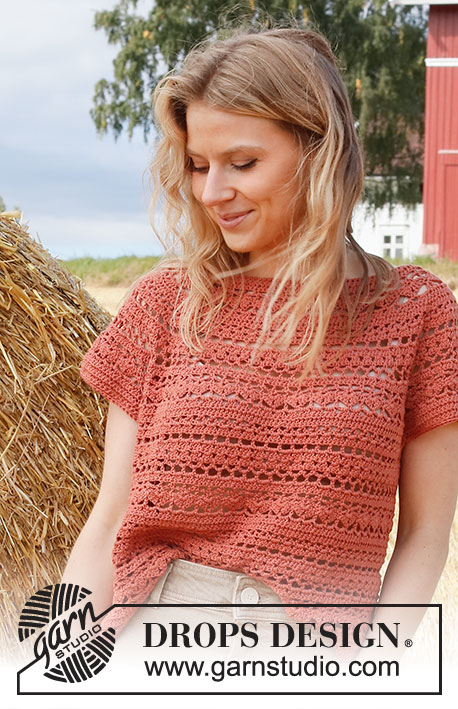

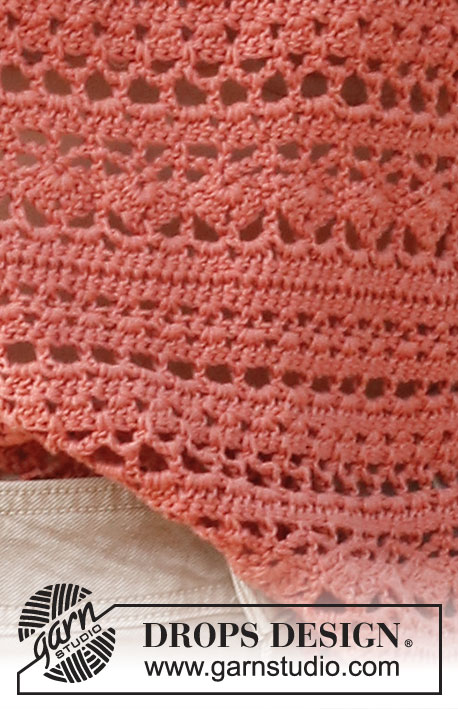


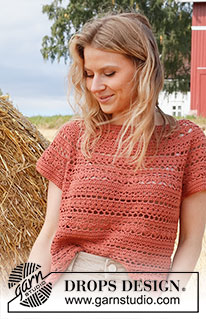
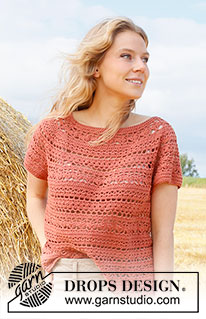
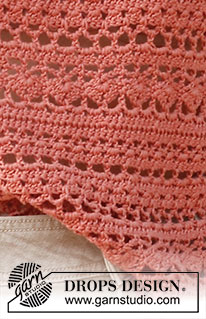














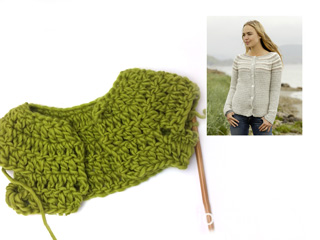



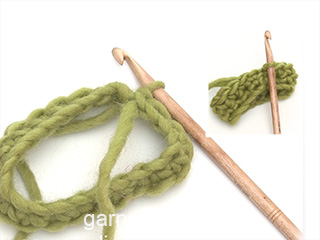























Comments / Questions (52)
En la fila siete del cuerpo se hace la V cada dos puntos o cada un punto? Gracias por el patrón, es precioso!
14.06.2021 - 12:23DROPS Design answered:
Hola Asun, se trabaja 2 puntos altos en 1 punto (V), se saltan dos puntos y en el siguiente se vuelve a trabajar la V.
27.06.2021 - 19:33Vanaf het begin eerste toer stokjes gemeerderd zoals aangegeven. Daarna telpatroon gevolgd op de tweede patroontoer zoals aangegeven (patroon met sterretje aan de voorkant niet haken A2 en A3, op de foto zie ik nu dat er bovenin volgens mij 2 stokjesranden zijn gehaakt vanaf de hals, klopt dit? Zoja is het echt noodzakelijk om dit dan uit te halen? Ik heb bijna A2 klaar. Of lost het zich later op als ik een pas lengte van 24cm aanhoudt voor maat L?.
14.06.2021 - 09:42DROPS Design answered:
Dag Wil,
Het lijkt er inderdaad op dat er nog een toer met stokjes is en ik denk dat deze tijdens het invoegen van de markeerdraden had moeten worden gehaakt. Het is natuurlijk niet noodzakelijk om dit alsnog te doen, je kan gewoon de lengte van 24 cm aanhouden.
24.06.2021 - 09:54Muita linda, porém não consigo entender essas numerações, por exemplo, no início crochetar 95.103.103.109.109.115 pontos correntes, o que significa?
08.06.2021 - 20:57DROPS Design answered:
Bom dia, O número de pontos inficado depende do tamanho que estiver a fazer. 95 pontos corrente para o tamanhoX S.103 para o tamanho S.103 para o tamanho M.109 para o tamanho L.109 para o tamanho XL.115 para o tamanho XXL. Bons crochés!
09.06.2021 - 09:46Bonjour, je ne comprend pas les explications : que faire lorsque sont réalisés les 6 premiers rangs A3 ? reprendre au début ? ou continuer A3a ? par rapport aux 14 rangs A2 ? merci de vos conseils; Cordialement
01.06.2021 - 21:00DROPS Design answered:
Bonjour Mme Cornard, A.2 et A.3 sont les mêmes motifs, mais A.2 comporte des augmentations placées. Quand A.2 est terminé, on crochète alors A.3 (= plus d'augmentations pour l'instant), vous crochetez A.3 jusqu'à la hauteur indiquée pour votre taille en ajustant sur le rang indiqué et vous divisez ensuite l'ouvrage au rang suivant pour continuer séparément le dos/le devant et les manches. Bon crochet!
02.06.2021 - 07:42Bonjour, Juste pour être sûre : A3a comporte bien 14 rangs? Donc une fois arrivée à 24cm (taille L), je peux m'arrêter après le rang 7 donc le rang d'arceaux de ms,4ml et ensuite faire l'emmenchure au tour suivant (rang 8 : 1br,2ml) avec les 2x10ml pour les emmenchures ? Merci à vous
31.05.2021 - 18:36DROPS Design answered:
Bonjour Mme Crickx, effectivement, le dernier rang de l'empiècement doit être un rang 1,3, 7, 12 ou 13 de A.3a, donc vous pouvez diviser l'ouvrage après un rang 7 pour crocheter le 8ème tour du diagramme pour la division des manches - avec la maille en l'air avant/après celles des emmanchures, 1 des mailles en l'air appartiendra à A.3a au 9ème tour. Bon crochet!
01.06.2021 - 08:15Hola, he visto que se ha publicado el patrón en inglés, lo puedo encontrar en español en un algún sitio de la web?
12.05.2021 - 14:46DROPS Design answered:
Hola Angela. El patrón está publicado en castellano: https://www.garnstudio.com/pattern.php?id=10254&cid=23
16.05.2021 - 17:23Puedo encontrarlo en español?
12.05.2021 - 00:38DROPS Design answered:
Hola Mayte, espera un momento, el patron esta traducido. Cordiales saludos!
13.05.2021 - 17:05Me gusta. Creo que podré hacerlo!!
10.05.2021 - 11:09¿Cuándo estará disponible este patrón? Compré el hilo Safran y estoy esperando para tejerlo cuanto antes.
07.05.2021 - 20:00DROPS Design answered:
Hola Ángela, este patrón estará publicado proximamente.
09.05.2021 - 19:51Wanneer komt het online. Binnenkort is geen 4 maanden. Kunt u aangeven wanner dan wel?
28.04.2021 - 10:02